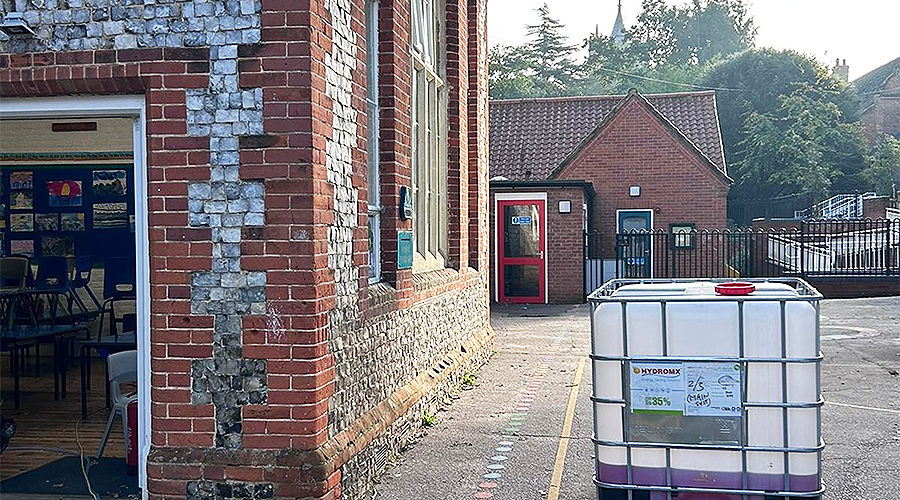After staffing costs, energy bills are often the next biggest spend for schools. And with the demise of the Government’s Energy Bills Discount Scheme – with no replacement on the horizon – education budgets look set to be further squeezed, says Dominic Wish, HMX UK’s Technical Director.
HMX UK
Implementing energy-saving measures in primaries and secondaries is an ongoing focus for local authorities, academies and other organisations driving to hit net-zero targets and reduce energy bills in educational establishments.
Improved lighting, renewables, energy audits and upgrading heating systems are often starting points. An Environmental, Social, and Governance (ESG) strategy can also be a powerful tool not just to manage energy costs but also enhance a school’s reputation and deliver learning opportunities for pupils.
So with these established routes to better manage energy bills is there demand for another approach? We think so, as do our clients, who are benefitting from a relatively straightforward approach that has already delivered energy and cost savings of 35% and more for a group of schools in Essex.
Comfort levels
The Diocese of Chelmsford became the first in the country to adopt cutting-edge technology for the voluntary-aided primary schools in its portfolio. The move saw it add a product called Hydromx to central heating systems in more than 30 schools with almost immediate effect, with heads reporting that hard-to-heat offices and other areas of their schools were far more comfortable heat wise. One said: “It’s such a great product. Everybody I have spoken to can’t quite believe how good it is.”
But while comfort levels are important, the real impact is in fuel bills and carbon emissions, with one school making a saving on its energy bill equivalent to its yearly book budget.
Prior to introducing Hydromx across its school portfolio, the Diocese – which is working towards a net-zero commitment – conducted a pilot project to assess the product’s performance, installing it in five schools. Of these, three recorded before and after energy usage statistics reveal gas consumption savings of between 37.5 and 47% from November 2022 to January 2023 when compared to the previous year (with an HDD – Heating Degree Day – calculation applied). ROI ranges from 1.42 years to 2.18 years. It should be noted that the schools fitted TRVs to manage the heating and ensure optimum savings. There has also been a significant focus on energy saving within each, leading to these outstanding results. Reduction in carbon emissions of around seven tonnes per site per year are predicted.
Guaranteed
Hydromx is a cutting-edge heat transfer solution that improves the thermal conductivity of fluid within hydronic (water-based) heating and cooling systems. It is in use worldwide (New York’s Empire State Building has been benefitting from it for years, reducing chiller run time and cutting plant electricity bills by up to 50% in some cases) and is compatible with most HVAC systems. No major plant or system changes are required. The additive is non-invasive, inert, recyclable and guaranteed for 20 years. It performs the tasks of an inhibitor, protecting against calcification, corrosion, freezing, bacteria and algae growth. Depending upon the application and system characteristics, building operators and owners can expect carbon and cost savings of between 20 to 35%.
Installation
There are two key elements of installation – assessing system volume and ensuring it is clean (which usually means flushing to remove sludge and inhibitors. This process can also help ascertain volume if unknown). The heating/cooling system should be in good condition. Remedial work, if required (for example, the fitting of thermostat radiator valves), should be carried out prior to installation to ensure increased heat output can be managed. Boiler sequencing/thermostats will also need adjusting accordingly.
The Chelmsford Diocese school installations have all been carried out after school hours, over weekends or during holidays, with most taking less than a day. Once the heating system is confirmed as suitable (flushed, no leaks, TRVs fitted, remedial work completed etc.), it is drained down and refilled with a mix of water and Hydromx.
How it works
Economic and practical reasons have driven the use of water in central heating systems – it’s low cost and efficient. However, the development of Hydromx offers a new and far more efficient approach. At the heart of the product is nano-technology; it’s an accepted scientific principle that material properties change as size approaches the atomic scale, with the surface-area-to-volume ratio increasing. A cup of nanoparticles offers roughly the same surface area as almost two football pitches, and increased surface area equals increased heat transfer capability.
Nanoparticles are already an established technology delivering benefits in a variety of fields, from paints to glass, aerospace to medicine and even school uniform. Their use isn’t new within heating applications either but scientific advancements mean these tiny particles are now delivering substantial environmental and cost-saving advantages. Sound scientific principles support their use and worldwide installations demonstrate results.
The approach is simple – replace water in hydronic systems with a fluid that has superior heat transfer properties. Not only does the heating or cooling system reach the desired temperature more quickly (therefore, using less energy), but cycling is also reduced, offering the potential of increased equipment lifespan and lower maintenance requirements. It’s a win-win situation and can even negate the need for new plant if increased heating/cooling is required.
In many ways, it’s an obvious solution to make commercial HVAC systems work more efficiently. But applying fluid technology to this area has been largely overlooked until now and it’s challenging clients, specifiers and contractors to reconsider a fundamental element of HVAC systems.











